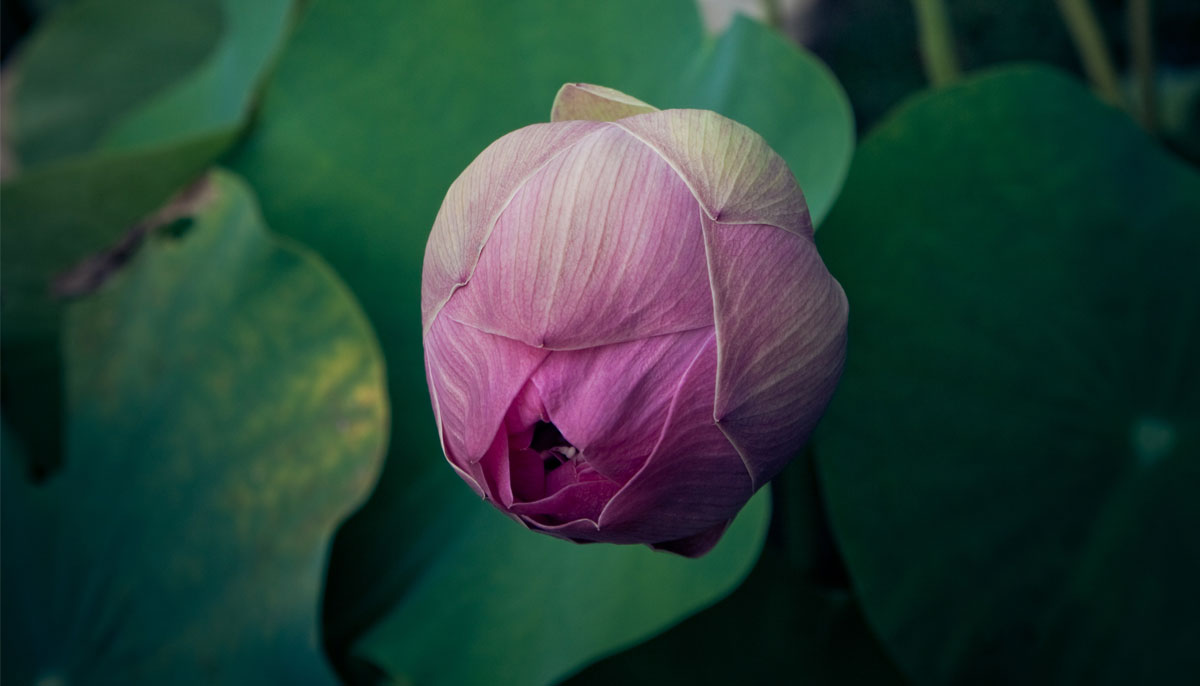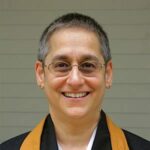The news is not good these days, and I suspect it never has been. Our hearts break as we witness the suffering of the world. We notice that all human beings appear to be blinded by oppositional thoughts and terrible feelings. Even little babies, screaming and crying for what they want, seem plagued by the three poisons of greed, anger, and ignorance.
To explain the human tendency toward the negative, some religions came up with the doctrine of original sin: we were born bad, so we have to force ourselves to repent and change our negative thinking and harmful behaviors.
The Mahayana Buddhist teachings offer a different and more hopeful view of our fundamental nature. The good news of Mahayana Buddhism is that we are already awakened beings, and the negativity that obscures our true nature is impermanent and temporary.
In the dualistic view, we strive to transform evil into good—to oppose greed, anger, and ignorance with generosity, kindness, and clarity. In the nondual view of the Mahayana, we embrace everything that arises, good and bad, right and wrong, as examples of the awakened nature that fills the universe. The word “buddha” derives from the Sanskrit word for “awake,” so we call this awakened nature buddhanature.
There is nothing in the universe outside of this awakened nature.
Buddhanature is the ground of all being. It is neither good nor bad, although it is not neutral. It has the flavor of compassion and clarity and promises relief from the mind that creates division and clings stubbornly to a separate self. Sometimes we say that everyone already has buddhanature, or in the words of Eihei Dogen, the thirteenth-century Japanese Zen teacher, everyone is buddhanature.
But what of the negativity that plagues human life and society? The good news is that these are just temporary obscurations of our buddhanature, not a permanent part of who we are.
In Buddhism, we say that the three poisons of greed, anger, and ignorance form the basic ingredients of our suffering. Like poison, they contaminate the balance, clarity, and kindness of our true nature. These fundamental or root poisons of greed, anger, and ignorance, alone and in combination, make up all of the endless varieties of our suffering in thought, emotion, and action.
In Sanskrit, the word for these poisons is klesha, which has the connotation of something that obscures or covers. Kleshas are said to be like clouds that cover the sun, which is always shining but is sometimes hidden from view. They hide the reality of our buddhanature from our conscious awareness.
The three poisons can combine to create all kinds of unhappiness, and they seem very real when we are in their grip. The way we are driven by these elemental forces can be seen easily when we look directly at our behavior, thoughts, and inner feelings. We notice that there are all kinds of thoughts that begin with the phrases “I want,” “I hate,” and “I don’t care.” It’s hard for us to see beyond these habits of mind, which of course lead to even more destructive habits of behavior.
All the kleshas are based on dualism: me and you, happiness and suffering, good and bad, right and wrong. From the nondual viewpoint, the mind that only sees opposites is distorted and can’t comprehend the reality of pervasive, awakened nature without falling in and out of dualism. We cling to the “everything sucks” view until it seesaws into “everything is beautiful.” Without a nondual view, we go back and forth endlessly in dualities.
There are many names for this nondual, awakened nature. We can describe it as unborn, free from categories, free from clinging, and free from self. It is always present. It cannot be opposed or attained. It can’t be understood by the discursive mind. It can only be known by the awakened heart/mind. Bodhidharma, the fifth-century Indian teacher who is said to have brought Zen to China, says that buddhanature is “inconceivably wondrous.”
There is more good news. Buddhanature is not just limited to human beings. There is nothing in the universe outside of this awakened nature.
In the undivided reality that holds all opposites, everything reveals the truth of awakening. Animals and plants, tiles and walls, trees and stars all demonstrate buddhanature. For the mind that endlessly creates dualistic thoughts and views, this is hard to understand. But once it is seen, it is indeed wondrous and profoundly reassuring.
Although awakened nature sounds special, it is actually profoundly ordinary. And it is not something we have to create. It appears naturally from the ground of our being, poking through our thoughts, feelings, and behaviors like blades of grass growing up from the ground.
The entry point to knowing our own awakened nature is very simple—it is experiencing who are we without accepting, rejecting, or judging anything. But while simple, it’s not easy, because our usual way of being is based so strongly on the dualism and distortion of self-improvement. We try so hard to be good and wise. We are addicted to striving. We decide that the parts of ourselves that we don’t like are not us, and we work really hard to eliminate them. All of us carry some image of who we should be, and we try to kill the unruly parts so we’ll become our idealized selves.
In denying parts of ourselves, we miss the continuing arising of the awakened heart, which is the source of passion and delight. We are fooled by the three poisons, which we see as permanent and believe we must oppose. But all these adventitious arisings are not permanent, and they can’t help but disperse if we stop interfering with them.
Instead of trying to kill off parts of ourselves, we can practice nondual meditation. We can uncover what has been hidden by our adventitious thinking but is always present. Through this practice our buddhanature is revealed. It is always here, but we can’t know this until we embrace our whole being, including the delusions and the parts of us that are unwanted.
How do we practice this uncovering? We watch all the arisings in the body and heart/mind and see them for what they are: temporary phenomena, taking shape as thoughts, feelings, perceptions, opinions, and sensations. Because we have seen them to be impermanent, we learn to stop trusting and relying on them.
If you want to set up the conditions to recognize your awakened nature, all you have to do is sit down, be still and upright, and stay awake to whatever is here. Whenever anything arises in awareness—whether a thought, feeling, or sense perception—don’t run after it. Don’t fight it or try to transform it either.
There’s nothing to do and nowhere to go. There is nothing to try to figure out or eliminate.
This practice takes a while to get the hang of, because it’s essentially doing not-doing. Dogen describes it as thinking not-thinking. Be curious: just watch what happens to all of these arisings when you stop meddling with them.
But be careful: there is a trap that can appear even when we are doing uncovering meditation practice. The dualistic mind wants to make a fixed concept of everything, including buddhanature. This includes any fixed idea of awakening or attainment you may have as you begin to recognize the undeniable fact of buddhanature in yourself and in the world around you.
In nondual practice, there’s nothing to do and nowhere to go. There is nothing to try to figure out or eliminate. Again and again, recognize that what arises is simply what arises. Gradually, what is at first merely glimpsed as the space between passing thoughts begins to have a stronger presence in your conscious awareness. You recognize something that is not limited to or by thoughts, sense perceptions, or physical sensations.
This sense of spaciousness is the recognition of your awakened nature. You also see without a doubt that compassionate action arises naturally from this. You realize that you have always been filled with the tremendous energy of bodhichitta, the awakened heart/mind of the Buddha.
But as much as you’d like to, you can’t make this transformation happen. You can set up the conditions for it to be realized, but as soon as self-centered striving enters the picture, you’re lost again in duality. Yet even your self-centered striving has to be recognized for what it is—a temporary phenomena—and not pushed away.
When you gently hold everything you encounter in your open hands, even your anger, greed, ignorance, and striving, the energy contained in all this troublesome activity transforms and releases itself. That is the very nature of phenomena: to change and transform and release. When you don’t interfere or identify with anger, but hold it gently in conscious awareness, it transforms, all by itself, into clarity. Greed transforms into compassion and the wish to connect. Ignorance transforms into the profound experience of settling deeply into the moment, just as it is, beyond any stories or concepts. Even suffering, when you can simply let it be without trying to eliminate it, is revealed as part of your awakened nature. There are no exceptions—everything is buddhanature.
Of course, we all love to make up stories and concepts, and we’re really good at it. These too are part of the vast undifferentiated reality we call buddhanature, and are not to be rejected. We only need to see them for what they are—a created linking of random thoughts that produce meaning for us.
In the Mahayana teachings, we sometimes conceptualize the transformed energies of the kleshas as human-like beings. Manjushri, the bodhisattva of wisdom, carries a sword that cuts through delusion. Avalokiteshvara, the bodhisattva of compassion, sometimes appears with a hundred arms to help all beings in the world and a hundred eyes to see the endless varieties of suffering. There is a lovely story in the Zen tradition about her.
A student asks a teacher, “What does the bodhisattva of great compassion do with all those hands and eyes?”
The teacher responds, “It is like a person groping for her pillow in the middle of the night.”
The awakened heart is who we are, and it can’t help but act through us.
Practicing in this way, gradually, over days and months and years, our life is permeated by the sense of being buddhanature itself. There is indeed a transformation, but we don’t make it happen. We only set up the conditions for what is natural to arise.
This practice does not protect us from sorrow. The three poisons continue to show up and fall away. Our hearts become more tender as we continue to be present with everything that arises, because so much of what we witness is sorrow and suffering. Our hearts break, and these broken hearts reveal themselves as buddhanature. We feel a new power that is not personal, beyond happiness and sorrow, beyond good and bad, right and wrong.
And then we have no choice but to go out and engage with a world that is simply ourselves. We do not strive to repair what is broken. Instead, with an energetic, awakened heart, we engage with the world directly. The Buddha said that the world is on fire, and although it is burning, it is the only world we have. It is not nice but it is perfect and complete. It is alive with inconceivable wonder.

